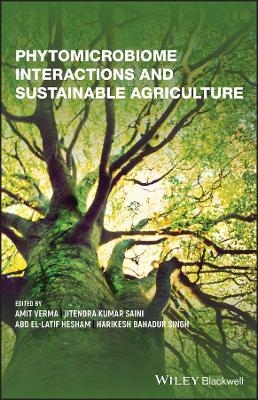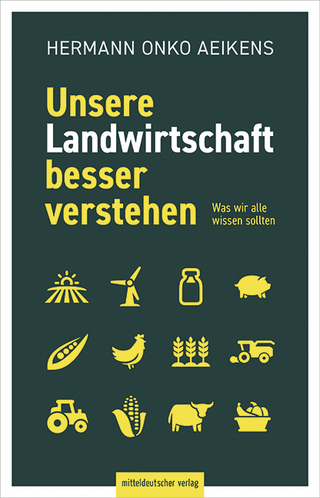
Phytomicrobiome Interactions and Sustainable Agriculture
Wiley-Blackwell (Verlag)
978-1-119-64462-0 (ISBN)
Phytomicrobiome Interactions and Sustainable Agriculture offers an essential guide to the importance of ‘Phytomicrobiome’ and explores its various components. The authors – noted experts on the topic – explore the key benefits of plant development such as nutrient availability, amelioration of stress and defense to plant disease. Throughout the book, the authors introduce and classify the corresponding Phytomicrobiome components and then present a detailed discussion related to its effect on plant development: controlling factors of this biome, its behaviour under the prevailing climate change condition and beneficial effects.
The book covers the newly emerging technical concept of Phytomicrobiome engineering, which is an advanced concept to sustain agricultural productivity in recent climatic scenario. The text is filled with comprehensive, cutting edge data, making it possible to access this ever-growing wealth of information. This important book:
Offers a one-stop resource on phytomicrobiome concepts
Provides a better understanding of the topic and how it can be employed for understanding plant development
Contains a guide to sustaining agriculture using phytomicrobiome engineering
Presents information that can lead to enhanced production and productivity to feed our growing population
Written for students, researchers and policy makers of plant biology, Phytomicrobiome Interactions and Sustainable Agriculture offers a clear understanding of the importance of microbes in overall plant growth and development.
AMIT VERMA is Assistant Professor in the Department of Biochemistry, S.D. Agricultural University, India. JITENDRA KUMAR SAINI is Assistant Professor in the Department of Microbiology at Central University of Haryana, India. ABD EL-LATIF HESHAM is Professor of Microbial Genetics and Environmental Meta-Genome Biotechnology at Genetics Department, Faculty of Agriculture, Beni-Suef University, Egypt. HARIKESH BAHADUR SINGH is Professor of Excellence, Department of Biotechnology, GLA University, Mathura, Uttar Pradesh, India.
List of Contributors xii
Preface xvi
About the Editors xviii
1 Plant Root Exudate Analysis: Recent Advances and Applications 1
Shulbhi Verma and Amit Verma
1.1 Introduction 1
1.2 Root Exudates Composition: Collection and Analysis 3
1.3 Role of Root Exudates in Shaping Rhizospheric Microbiomes 5
1.4 Applications of Root Exudation 6
1.5 Conclusion and Future Prospects 7
References 10
2 Phytoproteomics: A New Approach to Decipher Phytomicrobiome Relationships 15
Prachie Sharma and Kapila Kumar
2.1 Introduction 15
2.2 Phytomicrobiome 16
2.3 Phytomicrobiome: The Communication via Signaling 18
2.4 Proteomics 19
2.4.1 Gel-Based Protein Separation Techniques 21
2.4.2 Non-Gel Protein Separation Techniques 21
2.5 Analysis of Phytomicrobial Interactions Using Proteomics Approaches 22
2.6 Conclusion and Future Prospects 26
References 28
3 Metagenomics: An Approach to Unravel the Plant Microbiome and Its Function 32
Ravindra Soni, Deep Chandra Suyal, Balram Sahu, and Suresh Chandra Phulara
3.1 Introduction 32
3.2 Metagenomics 33
3.3 Metagenomics of Plant Rhizosphere 33
3.4 Metagenomics of Plant Phyllosphere 35
3.5 Metagenomics of Plant Endosphere 36
3.6 In-silico Tools for Metagenome Analysis 37
3.6.1 Mothur 37
3.6.2 Quantitative Insights into Microbial Ecology (QIIME) 37
3.6.3 MEta Genome Analyzer (MEGAN) 38
3.7 Recent Progress in Metagenomic Studies of Plant Microbiome 38
3.8 Conclusion and Future Prospects 38
References 38
4 Combating the Abiotic Stress Through Phytomicrobiome Studies 45
Hemant S. Maheshwari, Abhishek Bharti, Richa Agnihotri, Ajinath Dukare, B. Jeberlin Prabina, Saurabh Gangola, and Mahaveer P. Sharma
4.1 Introduction 45
4.1.1 Abiotic Stress and Phytomicrobiome 45
4.1.2 Role of Signaling in Phytomicrobiome Interactions 46
4.2 Phytomicrobiome Signaling Compounds 47
4.2.1 Root Exudates and Plant Volatiles Compounds 47
4.2.2 Microbial Volatile Organic Compounds 47
4.2.3 Quorum Sensing 48
4.2.4 Underground Phytomicrobiome Signaling 48
4.3 Mechanisms of Phytomicrobiome Associated with Abiotic Stress Tolerance 49
4.3.1 Drought Stress Alleviation 50
4.3.2 Salinity Stress Mitigation 53
4.3.3 Heavy Metal Toxicity 55
4.3.4 Low-Temperature Stress 56
4.3.5 Nutrient Deficiency 56
4.3.6 Flooding or Water Submergence 56
4.4 Importance of Phytomicrobiome Engineering for Crop Stress Alleviation 57
4.5 Omics Strategies in Phytomicrobiome Studies 58
4.6 Conclusion and Future Prospects 59
Acknowledgments 59
References 60
5 Microbial Diversity of Phyllosphere: Exploring the Unexplored 66
Rakhi Dhankhar, Aparajita Mohanty, and Pooja Gulati
5.1 Introduction 66
5.2 Origin of Phyllosphere Microflora 67
5.3 Tools to Study Phyllomicrobiome 68
5.3.1 Conventional Methods 69
5.3.2 Microscopic Techniques 69
5.3.3 First-Generation Molecular Techniques 70
5.3.4 Next-Generation Sequencing Methods 70
5.3.5 Omics and Bioinformatics Approaches 76
5.3.6 Other Molecular Methods 77
5.4 Biodiversity of Phyllosphere 77
5.5 Microbial Adaptation to Phyllosphere 78
5.5.1 Adaptation to Abiotic Stresses 79
5.5.2 Adaptation to Biotic Stresses 80
5.5.3 Adaptation to Nutrient Scarcity 81
5.6 Interaction of Phyllomicrobiota with Plants 81
5.6.1 Positive Interactions 82
5.6.2 Negative Interactions 83
5.7 Significance of Phyllomicrobiome Studies 83
5.8 Conclusion and Future Prospects 84
References 85
6 Rhizosphere Engineering: An Effective Approach for Sustainable Modern Agriculture 91
Reema Mishra, Tripti Grover, Pooja Gulati, and Aparajita Mohanty
6.1 Introduction 91
6.2 Natural Plant–Microbe Interactions in Rhizosphere 92
6.3 Molecular Mechanisms in Plant–Microbe Interactions in Rhizosphere 93
6.4 Biochemical Components in Rhizosphere Signaling 94
6.5 Tools and Techniques in Rhizosphere Engineering 96
6.5.1 Stable Isotope Probing (SIP) 96
6.5.2 DNA Arrays 97
6.5.3 Fluorescence In Situ Hybridization (FISH) 97
6.5.4 Bioreporters 97
6.5.5 Genomics 98
6.5.6 Transcriptomics 98
6.5.7 Proteomics 99
6.5.8 Metabolomics 99
6.6 Rhizosphere Components Amenable to Engineering 100
6.6.1 Soil Modification 100
6.6.2 Plant Amendment 100
6.6.2.1 Root Exudate Modification 100
6.6.2.2 Root Architecture Modification 101
6.6.2.3 Enhancing Abiotic Stress Tolerance in Plants 101
6.6.2.4 Enhancing Biotic Stress Tolerance in Plants 103
6.6.2.5 Engineering Metabolic Pathways in Plants 105
6.6.3 Engineering Microbial Populations 107
6.7 Conclusion and Future Prospects 107
Acknowledgment 108
References 108
7 Plant Communication with Associated: Its Components, Composition and Role in Maintaining Plant Homeostasis 118
Dibyajit Lahiri, Moupriya Nag, Sayantani Garai, Bandita Dutta, and Rina Rani Ray
7.1 Introduction 118
7.2 Biofilm and Rhizospheric Interactions 119
7.3 Biofilm Formation at the Root Rhizosphere 120
7.3.1 The Components of Biofilm Matrix 121
7.3.2 Bacterial Quorum Sensing 122
7.4 Genetic Features Responsible for Bacterial Cell Adhesion to Plant System 125
7.4.1 Chemotaxis Motility 125
7.4.2 Substrate Utilization and Transport 125
7.4.3 Lipopolysaccharide and Membrane Proteins 126
7.4.4 Plant Cell Wall Modification 127
7.4.5 Adhesion and Biofilm Formation 128
7.4.6 Stress Protection 128
7.4.7 Bacterial Secretion System 129
7.4.8 Transcriptional Regulators and Sensor Proteins 130
7.5 Nutrient Interactions 138
7.5.1 Release and Activation of Minerals 138
7.5.2 Nutrient Recycling 138
7.5.3 Nitrogen Dynamics 138
7.5.4 Ionic Modification 139
7.6 Biotic Interaction 140
7.6.1 Symbiosis 140
7.6.2 Synergy 140
7.6.3 Competition 140
7.6.4 Antagonism 141
7.6.5 Pathogenesis 142
7.7 Conclusion and Future Prospects 142
References 143
8 Phytomicrobiome: Synergistic Relationship in Bioremediation of Soil for Sustainable Agriculture 150
Nimmy Srivastava
8.1 Introduction 150
8.2 Phytoremediation 151
8.2.1 Process of Phytoremediation 151
8.2.2 Strategies for Phytoremediation 151
8.3 Phytomicrobe Interactions and Rhizomediation 152
8.3.1 Principle of Phytomicrobiome Interaction During Rhizomediation 152
8.3.2 Removal of Inorganic Contaminants 154
8.3.3 Removal of Organic Pollutants 154
8.3.4 Factors Affecting Rhizomediation 157
8.4 Conclusion and Future Prospects 157
References 158
9 Rhizospheric Biology: Alternate Tactics for Enhancing Sustainable Agriculture 164
Kalpana Bhatt and Pankaj Bhatt
9.1 Introduction 164
9.2 Engineering the Rhizosphere 165
9.2.1 Rhizosphere and Rhizobia 165
9.2.2 Root Exudates: Chemical Nature and Types 167
9.2.3 Factors Affecting Root Exudate 168
9.3 Engineering Soil Microbial Populations and Plant–Microbe Interactions 169
9.3.1 Microorganisms in Soil 169
9.3.2 Soil Modification: Altering Microbial Populations 170
9.4 Plant Growth-Promoting Rhizobacteria: Mechanisms, Potential, and Usages 170
9.4.1 Direct Mechanisms 171
9.4.1.1 Biological N2 Fixation 171
9.4.1.2 Phosphate Solubilization 173
9.4.1.3 Zinc Solubilization 174
9.4.1.4 Siderophore Production 174
9.4.1.5 Production of Phytohormones 174
9.4.1.6 ACC (1-Aminocyclopropane-1-Carboxylate) Deaminase Activity 175
9.4.2 Indirect Mechanisms 175
9.5 Plant–Microbe Interaction 176
9.6 Biofertilizers and its Applications 177
9.7 Plant Genetic Engineering 177
9.8 Conclusion and Future Prospects 178
Acknowledgments 178
References 179
10 Application of Inorganic Amendments to Improve Soil Fertility 187
Sunita Chauhan and Shweta Kulshreshtha
10.1 Introduction 187
10.2 Impact of Bhoochetna Movement in Southern India 188
10.3 Sustainable Agriculture 188
10.3.1 Healthy Soil and Soil Quality 189
10.3.2 Soil Quality 189
10.3.3 Soil Quality Indicator 190
10.3.4 Soil Quality Index 191
10.4 Factors to Be Considered While Selecting a Soil Amendment 192
10.5 Advantages of Soil Amendments 194
10.6 Land Modeling 194
10.7 Major Applications of Soil Amendments 195
10.7.1 Phyto-Stabilization in Polluted or Contaminated Soils 195
10.7.2 Restoration of Soil 196
10.7.2.1 Soil Acidity/pH Soil Amendments 196
10.7.2.2 Mineral Soil Amendments and Conditioners 196
10.7.2.3 Different Types of Inorganic Amendments 197
10.8 Combination Strategy for Soil Quality Improvement 202
10.9 Conclusion and Future Prospects 203
References 203
11 Improved Plant Resistance by Phytomicrobiome Community Towards Biotic and Abiotic Stresses 207
Neha Trivedi
11.1 Introduction 207
11.2 Microbes and Plants 207
11.2.1 Abiotic Stress Responses and Microbe-Mediated Mitigation in Plants 208
11.2.2 Microbial-Induced Response to Stresses 208
11.3 Response of Abiotic Response on Plant 209
11.3.1 Induced Systemic Tolerance (IST) 209
11.3.2 Metabolic Changes in Plants Induced by Microbes During Stress 209
11.3.2.1 Metabolic Cross-Talk in Plants After Stress Induction 210
11.3.2.2 Activation of Antioxidant Mechanism 210
11.3.2.3 Activation of Systemically Induced Resistance 210
11.4 Role of Phytohormones in Increasing Abiotic and Biotic Stress Tolerance 211
11.5 Gene Transfer in Plants 212
11.6 Conclusion and Future Prospects 212
References 212
12 Bioprospecting: At the Interface of Plant and Microbial Communities 217
Madan L. Verma, Varsha Rani, Reena Kumari, Deepka Sharma, Sanjeev Kumar, and Rekha Kushwaha
12.1 Introduction 217
12.2 Plant-Associated Microbial Communities 218
12.3 Beneficial Effects of Plant-Associated Microbial Communities 222
12.3.1 Rhizoremediation 223
12.3.2 Plant Growth–Promoting Rhizobacteria (PGPR) 223
12.3.3 Biotic and Abiotic Stress Resistance 224
12.3.4 Signalomics 226
12.4 Role of Microbial Processing (Signals) in Facilitating Plant Growth 226
12.5 Conclusion and Future Prospects 230
Acknowledgments 230
References 231
13 Advances in Omics and Bioinformatics Tools for Phyllosphere Studies 240
Hina Bansal
13.1 Introduction 240
13.2 Recent Trends and Approaches 241
13.3 Computing for Biology 243
13.4 Bioinformatics in Microbial Research 243
13.5 Phyllosphere Microbiome Studies Based on Genome-Wide Association 245
13.6 Omics Strategies and Their Integration 246
13.6.1 Metagenomics 246
13.6.2 Metatranscriptomics 246
13.6.3 Metabolomics 247
13.6.4 Proteomics 247
13.7 Conclusion and Future Prospects 248
References 248
14 Microbial Mediated Zinc Solubilization in Legumes for Sustainable Agriculture 254
Pawan Saini, Sharon Nagpal, Pooja Saini, Arun Kumar, and Mudasir Gani
14.1 Introduction 254
14.2 Chronological Events of Zinc Biology 255
14.3 Role of Zinc in Living System 256
14.3.1 Essentiality of Zinc in Humans 256
14.3.2 Essentiality of Zinc in Plants 257
14.4 Zinc Deficiency vs. Zinc Toxicity in Crop Plants 259
14.5 Availability of Zinc in Soil Environment 260
14.6 Factors Affecting Zinc Availability to Plants 261
14.7 Response of Legume Crops to Zinc 262
14.8 Microbial Mediated Zinc Solubilization in Legume Crops 263
14.8.1 Zinc-Solubilizing Bacteria (ZnSB) 264
14.8.2 Zinc-Solubilizing Fungi (ZnSF) 265
14.9 Conclusion and Future Prospects 266
References 266
15 Composition and Interconnections in Phyllomicrobiome 277
Meghmala Waghmode, Aparna Gunjal, Neha Patil, and Sonali Shinde
15.1 Introduction 277
15.2 Significance of Phyllospheremicrobiota 279
15.3 Phyllosphere Microorganisms as Plant Growth Regulator 280
15.3.1 Plant Growth Hormones Production by Phyllosphere Microorganisms 280
15.3.2 Phosphorus Solubilization by Phyllosphere Microorganisms 280
15.3.3 Siderophores Production by Phyllosphere Microorganisms 280
15.3.4 Phyllosphere Microorganisms as Biocontrol Agents Against the Phytopathogens 280
15.3.5 Phyllosphere Microorganisms to Reduce Biotic and Abiotic Stress 281
15.3.6 Synthesis of 1-Aminocyclopropane-1-Carboxylate Deaminase (ACC) 282
15.3.7 Phyllosphere Microorganisms in Nitrogen-Fixation 282
15.3.8 Frost Injury and Frost Control by Altering the Phyllosphere Microbiota 282
15.3.9 Remediation of Toxic Pollutants 283
15.3.10 Plant Probiotics 283
15.3.11 Role of Phyllosphere Microorganisms in Climate Change 284
15.3.12 Phyllosphere Microorganisms in Nutrient Yield and Increase of Plant Growth 284
15.3.13 Plant Hormones as Colonization Mediators of the Plant Leaves 284
15.4 Plant–Pathogen Interactions Mediated by Phyllosphere Microbiome 285
15.4.1 Interaction Dependent on the Ionome 285
15.4.2 Role of Secretory Systems and Secretory Products 285
15.4.3 Quorum Sensing 286
15.5 Conclusion and Future Prospects 286
References 286
| Erscheinungsdatum | 25.02.2021 |
|---|---|
| Verlagsort | Hoboken |
| Sprache | englisch |
| Maße | 170 x 244 mm |
| Gewicht | 709 g |
| Themenwelt | Naturwissenschaften ► Biologie |
| Weitere Fachgebiete ► Land- / Forstwirtschaft / Fischerei | |
| ISBN-10 | 1-119-64462-3 / 1119644623 |
| ISBN-13 | 978-1-119-64462-0 / 9781119644620 |
| Zustand | Neuware |
| Haben Sie eine Frage zum Produkt? |
aus dem Bereich


